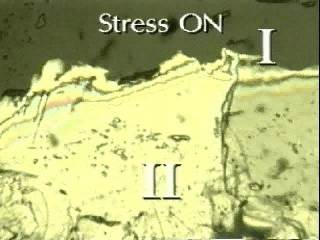
Phase Transformations with an Externally Applied Stress
The II to I transformations are extremely sensitive to shear stress. The application of such a stress always induces the boundary between these phases (this boundary is initially stationary in a stable temperature gradient) to move so as to increase the volume fraction of the lower temperature phase. Under certain conditions, stress can induce spectacular instability of the phase boundary. However, the motion of the phase boundary apparently does not reflect the orientation of the applied shear stress. These types of behaviour have all been observed in thin films of NH4NO3 mounted between two glass slides (i.e. using techniques similar to those developed by Means 1989) on a FUTRONTM in-situ deformation apparatus. The apparatus has been modified firstly by replacement of the PID heater controller by a simple Variac to produce smooth ramps when changing temperatures. Secondly, the motor drive has been disconnected to allow for constant shear stress experiments to be conducted. For such experiments (Fig. 3), the stress is applied through the action of a small mass suspended from the end of one of the glass slides via a wire that rides around a small pulley. Mass can be added or removed so that shear stress can be changed quickly and reasonably smoothly. For interpreting every image seen on this CD, note that the NH4NO3 film is sandwiched between two glass slides, one closer to the viewer and one further away (Fig 3). Shear stress is applied via two glass 'pistons' (e.g. east and west of static image Fig 11) so that the plane of 'pure' shear is parallel to the specimen film plane with the specimen shortening in one direction and extending perpendicular to this. The expansion of the specimen perpendicular to the film plane is not known but must be relatively minor. Care is needed interpreting the images as the shortening sense is not fixed. For all static images, shortening is oriented east-west. This is also true for most of the movie sequences but see below.
In addition to microstructural changes, permanent change of shape (ie plastic deformation) of a polycrystalline specimen might also occur during a phase transformation if a shear stress that is less than the yield stress of the weaker phase is simultaneously applied. Repeated cycling through a phase transformation in the presence of such an applied stress can lead to very large strains, similar to those associated with superplasticity. This effect (Meike 1993), commonly termed transformation plasticity, has been observed in many metallic systems. Recently, similar behaviour has been observed in ammonium nitrate and other ionic crystals in experiments using a simple dead-load creep apparatus with bulk specimens (McLaren and Meike, 1996). This apparent weakness of a polycrystalline ammonium nitrate specimen during a phase transformation is independent of the nature of the transformation (i.e. displacive versus reconstructive) and appears to be the result of the small external stress biasing the direction in which the relatively large internal stresses (associated with the volume change at the transformation) operate. It is these internal stresses that drive the deformation: there is no intrinsic weakness of the specimen during the transformation.
These observations on ionic crystals may provide important geophysical information about deformation in the neighbourhood of the major discontinuities associated with phase transition zone of the Earth's mantle (Ringwood 1991).


